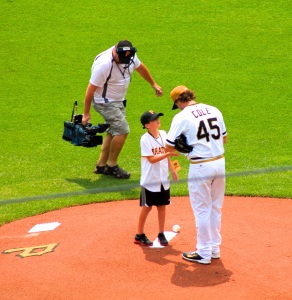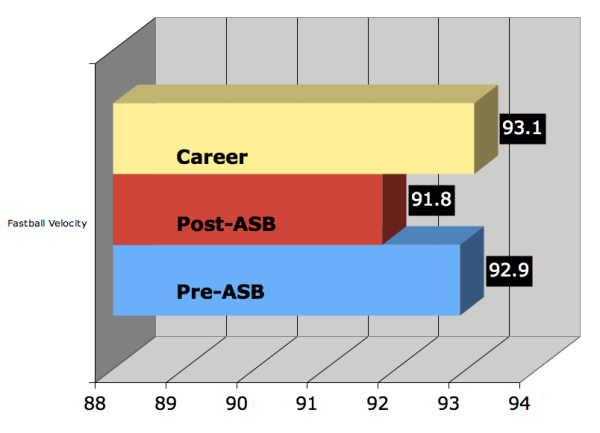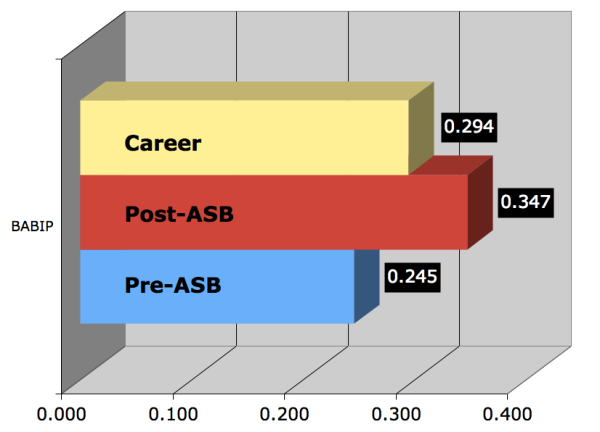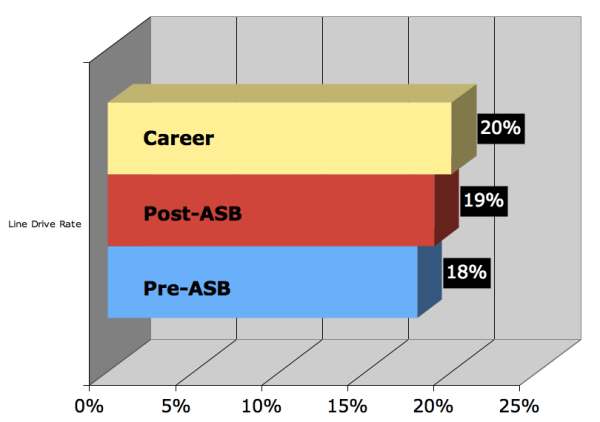
It’s just like being there!
For most MLB teams, it would be odd that the most popular blog writers live outside of the team’s home city. But this is Pittsburgh. Steel industry leaving, jobs available elsewhere, Pittsburgh Diaspora and so on.
Five of the most popular Pittsburgh Pirates bloggers don’t even live in Pennsylvania. Pat Lackey of Where Have You Gone, Andy Van Slyke is a grad student in North Carolina. Cory of Three Rivers Burgh Blog lives in Wisconsin. North Side Notch‘s Jim Rosati is in Kentucky. Tim Williams of Pirates Prospects lives in Virginia. So does Brian McElhinny of Raise The Jolly Roger, who studies at the University of Virginia.
How do these diehard fans and bloggers maintain the experience of watching a Pirates game with fellow fans, when any fellow fans are hundreds of miles away? With Twitter, of course. The five writers sport a combined 17,000 Twitter followers (give or take a few folks that might follow all or some of them). That is a lot of fellow fans to interact with. So what do these guys think of interacting with Pirates fans on Twitter? I asked them:
1. What are your overall feelings about Twitter?
 @WHYGAVS: I think my favorite thing about Twitter is that it can be whatever you want it to be; I can use it to have real discussions with both Pirate fans and the people that cover the team, I can use it to take the pulse of what other fans are thinking, I can use it to celebrate or commiserate a win or a loss, and on top of everything it’s hands down the best source of real-time news anywhere.
@WHYGAVS: I think my favorite thing about Twitter is that it can be whatever you want it to be; I can use it to have real discussions with both Pirate fans and the people that cover the team, I can use it to take the pulse of what other fans are thinking, I can use it to celebrate or commiserate a win or a loss, and on top of everything it’s hands down the best source of real-time news anywhere.
 @timwilliamsP2: Last year there was an earthquake about 30 miles away from my house in Virginia. I was in Pennsylvania at the time, but I was able to go on Twitter 10 seconds after my wife called me, do a search, and find that it was indeed an earthquake that shook our house. Twitter’s search is the best feature for current event topics, in my opinion. And as far as sports and prospects, it really sheds light on rising prospects. Just look at what the #FreeMattHague hash tag did for Hague’s recognition among Pirates fans.
@timwilliamsP2: Last year there was an earthquake about 30 miles away from my house in Virginia. I was in Pennsylvania at the time, but I was able to go on Twitter 10 seconds after my wife called me, do a search, and find that it was indeed an earthquake that shook our house. Twitter’s search is the best feature for current event topics, in my opinion. And as far as sports and prospects, it really sheds light on rising prospects. Just look at what the #FreeMattHague hash tag did for Hague’s recognition among Pirates fans.
 @ThreeRiversBlog: I also love it because it only lets you use 140 characters. I know sometimes I wish I could write one more sentence but it forces you to get your point across quickly. It can be a good and bad thing but for the most part I don’t want to read a three paragraph tweet. If I wanted to do that I would go read the person’s blog or articles.
@ThreeRiversBlog: I also love it because it only lets you use 140 characters. I know sometimes I wish I could write one more sentence but it forces you to get your point across quickly. It can be a good and bad thing but for the most part I don’t want to read a three paragraph tweet. If I wanted to do that I would go read the person’s blog or articles.
2. Has Twitter changed the way you watch Pirates games/sporting events?
 @NorthSideNotch: For me, being a Pittsburgh sports fan living in Louisville, KY, I can’t even watch games with friends or family who share that feeling of pulling for the same outcome. But when Twitter came along, you are suddenly involved and sharing thoughts and feelings about everything with hundreds of other people doing the same thing you are doing. Watching games on television are so much more fun because of that.
@NorthSideNotch: For me, being a Pittsburgh sports fan living in Louisville, KY, I can’t even watch games with friends or family who share that feeling of pulling for the same outcome. But when Twitter came along, you are suddenly involved and sharing thoughts and feelings about everything with hundreds of other people doing the same thing you are doing. Watching games on television are so much more fun because of that.
 @WHYGAVS: It definitely has. During games, keeping a Twitter client running is the internet equivalent of watching the game in a room full of fans. Was that pitch a strike? What is Clint Hurdle thinking? Was that error Barmes’s fault or Barajas’? I immediately have access to as many opinions as I need, which is very different from watching a game in an empty room.
@WHYGAVS: It definitely has. During games, keeping a Twitter client running is the internet equivalent of watching the game in a room full of fans. Was that pitch a strike? What is Clint Hurdle thinking? Was that error Barmes’s fault or Barajas’? I immediately have access to as many opinions as I need, which is very different from watching a game in an empty room.
 @ThreeRiversBlog: I think it has for me. When I am watching the game at home I have Tweetdeck open and just love seeing what other people have to say during the game. It might be jokes or what the team should do in a certain situation but there is nothing better than when a big play happens and you look at your timeline and everyone is freaking out about it. It is almost like you are there watching it with other people. When I am at games… and there is a close call it is nice to jump on Twitter to see what people are saying who are watching it on TV and have access to replays.
@ThreeRiversBlog: I think it has for me. When I am watching the game at home I have Tweetdeck open and just love seeing what other people have to say during the game. It might be jokes or what the team should do in a certain situation but there is nothing better than when a big play happens and you look at your timeline and everyone is freaking out about it. It is almost like you are there watching it with other people. When I am at games… and there is a close call it is nice to jump on Twitter to see what people are saying who are watching it on TV and have access to replays.
3. How much does Twitter/Facebook drive traffic to the site?
 @RTJR: Every time I post something, the link goes out to Twitter and Facebook and provides a decent bump in traffic (always depending on how interesting the post is, of course). I’d still run the site without it, but it would certainly be more difficult to promote my work.
@RTJR: Every time I post something, the link goes out to Twitter and Facebook and provides a decent bump in traffic (always depending on how interesting the post is, of course). I’d still run the site without it, but it would certainly be more difficult to promote my work.
 @TimWilliamsP2: For the first two years that the site was running, Twitter and Facebook was huge. Referrals represented over 50% of the traffic to the site, and Twitter was a key source… I’ve got about five times as many followers on Twitter than on Facebook. As for the referrals, Twitter represents 8% of the traffic to the site. Facebook sends 1% of the traffic to the site. Most of it these days is direct traffic. So the site would definitely be my full-time job without that traffic. However, that traffic helped get the site to this point.
@TimWilliamsP2: For the first two years that the site was running, Twitter and Facebook was huge. Referrals represented over 50% of the traffic to the site, and Twitter was a key source… I’ve got about five times as many followers on Twitter than on Facebook. As for the referrals, Twitter represents 8% of the traffic to the site. Facebook sends 1% of the traffic to the site. Most of it these days is direct traffic. So the site would definitely be my full-time job without that traffic. However, that traffic helped get the site to this point.
 @NorthSideNotch: All of my posts are linked to the Twitter and Facebook accounts for the web site. I would say that about half of the site’s daily traffic comes from clips from the links that are posted through social media sites. As far as maintaining the blog without that additional traffic, I would have to say I probably would still do it. However, the interaction with readers on Twitter and seeing the amount of content people will check out definitely makes it easier to maintain.
@NorthSideNotch: All of my posts are linked to the Twitter and Facebook accounts for the web site. I would say that about half of the site’s daily traffic comes from clips from the links that are posted through social media sites. As far as maintaining the blog without that additional traffic, I would have to say I probably would still do it. However, the interaction with readers on Twitter and seeing the amount of content people will check out definitely makes it easier to maintain.
4. Tim, has Twitter helped to drive book sales or in finding new writers?
 @TimWilliamsP2: I don’t really track where [book] sales originated. But I’m sure it’s like anything else in that it puts the product in front of more eyes. As for new writers, it has helped find a few contributors to the site, usually in the form of a guest post. A few weeks ago, I saw that someone I followed, who runs another site, saying they would be covering the West Virginia game today. I got in touch with them, and they’ll be contributing an article to the site. I wouldn’t have known about this person if it wasn’t for Twitter. When I was hiring a beat writer, one of the key requirements was that the person had Twitter and is very active on the service.
@TimWilliamsP2: I don’t really track where [book] sales originated. But I’m sure it’s like anything else in that it puts the product in front of more eyes. As for new writers, it has helped find a few contributors to the site, usually in the form of a guest post. A few weeks ago, I saw that someone I followed, who runs another site, saying they would be covering the West Virginia game today. I got in touch with them, and they’ll be contributing an article to the site. I wouldn’t have known about this person if it wasn’t for Twitter. When I was hiring a beat writer, one of the key requirements was that the person had Twitter and is very active on the service.
5. How do you think the Pirates organization can use Twitter better? Or do they already use it well?
 @ThreeRiversBlog: I think they could probably use it more to interact with fans. They are getting better at using it but I think it would be awesome if they used it for short interviews with players where they would take questions from fans. It’s all about give and take and trying different things. There is so much you can do with Twitter that all you have to do is ask a question and you will get thousands of responses, especially if you have as many followers as a professional team like the Pirates does.
@ThreeRiversBlog: I think they could probably use it more to interact with fans. They are getting better at using it but I think it would be awesome if they used it for short interviews with players where they would take questions from fans. It’s all about give and take and trying different things. There is so much you can do with Twitter that all you have to do is ask a question and you will get thousands of responses, especially if you have as many followers as a professional team like the Pirates does.
 @RTJR: I think they do a pretty decent job. I think MLB has some restrictions on stuff that official team accounts can post, but I don’t know exactly what those are. It is kind of alarming how few followers they have (47,000, not that much more than PNC Park’s capacity). My suggestions would be to try and reply and connect with fans more (see @Mariners) and create some sub-accounts to tweet specifically about things like tickets, in game promotions and entertainment, news/lineups, etc.
@RTJR: I think they do a pretty decent job. I think MLB has some restrictions on stuff that official team accounts can post, but I don’t know exactly what those are. It is kind of alarming how few followers they have (47,000, not that much more than PNC Park’s capacity). My suggestions would be to try and reply and connect with fans more (see @Mariners) and create some sub-accounts to tweet specifically about things like tickets, in game promotions and entertainment, news/lineups, etc.
 @WHYGAVS: I don’t really mind how the club uses it now, to be honest, which is to break news and keep fans updated about things happening at the ballpark… That said, I do think that teams like the Reds and Astros have done a good job putting their social media people forward on Twitter (Jamie Ramsay and Alyson Footer, respectively), to kind of give a face to the team beyond a faceless automaton. Given how tight-fisted this club is with the flow of information, I doubt we’ll ever see that happen.
@WHYGAVS: I don’t really mind how the club uses it now, to be honest, which is to break news and keep fans updated about things happening at the ballpark… That said, I do think that teams like the Reds and Astros have done a good job putting their social media people forward on Twitter (Jamie Ramsay and Alyson Footer, respectively), to kind of give a face to the team beyond a faceless automaton. Given how tight-fisted this club is with the flow of information, I doubt we’ll ever see that happen.
 @NorthSideNotch: I guess the one thing I would say they could improve on would be to use it as an advertisement more often, like having a free commercial spot. Perhaps it could be just sending out links to the ticketing site, posting promotional videos, running more specials on tickets, etc. The Pirates are a business, and like any business, they need customers. One of the best things about Twitter is that it allows you to reach a very broad customer base and it does not cost a penny. That needs to be taken advantage of.
@NorthSideNotch: I guess the one thing I would say they could improve on would be to use it as an advertisement more often, like having a free commercial spot. Perhaps it could be just sending out links to the ticketing site, posting promotional videos, running more specials on tickets, etc. The Pirates are a business, and like any business, they need customers. One of the best things about Twitter is that it allows you to reach a very broad customer base and it does not cost a penny. That needs to be taken advantage of.
—————————————-
Thanks to these guys for taking the time to email with me. Suffice to say, any Pirates fan on Twitter should consider them essential follows.
























